
Alberto Santos-Dumont, self-stylized as Alberto Santos=Dumont, was a Brazilian aeronaut, sportsman, inventor, and one of the few people to have contributed significantly to the early development of both lighter-than-air and heavier-than-air aircraft. The heir of a wealthy family of coffee producers, he dedicated himself to aeronautical study and experimentation in Paris, where he spent most of his adult life. He designed, built, and flew the first powered airships and won the Deutsch prize in 1901, when he flew around the Eiffel Tower in his airship No. 6, becoming one of the most famous people in the world in the early 20th century.

The history of aviation extends for more than two thousand years, from the earliest forms of aviation such as kites and attempts at tower jumping to supersonic and hypersonic flight by powered, heavier-than-air jets.
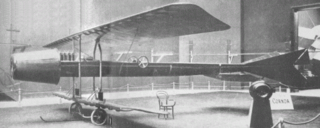
The Coandă-1910, designed by Romanian inventor Henri Coandă, was an unconventional sesquiplane aircraft powered by a ducted fan. Called the "turbo-propulseur" by Coandă, its experimental engine consisted of a conventional piston engine driving a multi-bladed centrifugal blower which exhausted into a duct. The unusual aircraft attracted attention at the Second International Aeronautical Exhibition in Paris in October 1910, being the only exhibit without a propeller, but the aircraft was not displayed afterwards, and it fell from public awareness. Coandă used a similar turbo-propulseur to drive a snow sledge, but he did not develop it further for aircraft.

Traian Vuia or Trajan Vuia was a Romanian inventor and aviation pioneer who designed, built, and tested the first tractor monoplane. He was the first to demonstrate that a flying machine could rise into the air by running on wheels on an ordinary road. He is credited with a powered hop of 11 m (36 ft) made on 18 March, 1906, and he later claimed a powered hop of 24 m (79 ft). Though unsuccessful in sustained flight, Vuia's invention influenced Louis Blériot in designing monoplanes. Later, Vuia also designed helicopters.
This is a list of aviation-related events from 1906:
The maiden flight, also known as first flight, of an aircraft is the first occasion on which it leaves the ground under its own power. The same term is also used for the first launch of rockets.

The 14-bis, also known as Oiseau de proie, was a pioneer era, canard-style biplane designed and built by Brazilian aviation pioneer Alberto Santos-Dumont. In 1906, near Paris, the 14-bis made a manned powered flight that was the first to be publicly witnessed by a crowd and also filmed. It was also the first powered flight by a non-Wright Brothers airplane aside from short powered "hops" by Clément Ader and Traian Vuia.

An airplane or aeroplane, informally plane, is a fixed-wing aircraft that is propelled forward by thrust from a jet engine, propeller, or rocket engine. Airplanes come in a variety of sizes, shapes, and wing configurations. The broad spectrum of uses for airplanes includes recreation, transportation of goods and people, military, and research. Worldwide, commercial aviation transports more than four billion passengers annually on airliners and transports more than 200 billion tonne-kilometers of cargo annually, which is less than 1% of the world's cargo movement. Most airplanes are flown by a pilot on board the aircraft, but some are designed to be remotely or computer-controlled such as drones.
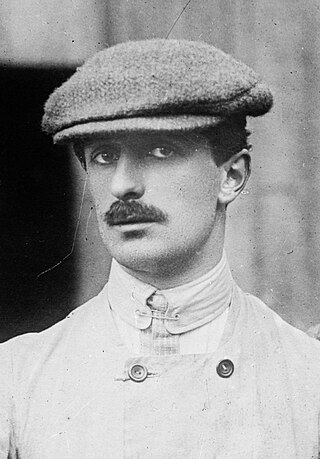
Gabriel Voisin was a French aviation pioneer and the creator of Europe's first manned, engine-powered, heavier-than-air aircraft capable of a sustained (1 km), circular, controlled flight, which was made by Henry Farman on 13 January 1908 near Paris, France. During World War I the company founded by Voisin became a major producer of military aircraft, notably the Voisin III. Subsequently, he switched to the design and production of luxury automobiles under the name Avions Voisin.
Romania has a rich tradition in aviation. At the beginning of the 20th century, pioneers such as Henri Coandă, Aurel Vlaicu, Traian Vuia and George Valentin Bibescu made important contributions to early aviation history, building revolutionary airplanes and contributing to the international scene.

The Blériot V was an early French aircraft built by Louis Blériot in 1907 and was his first monoplane. Although Blériot only achieved a couple of short flights in it, the second resulting in a crash which damaged the aircraft beyond repair, it was the first of his experimental aircraft to achieve any measure of success.

Louis Ferdinand Ferber was a French Army officer who played an important role in the development of aviation during the early 1900s. Although his aircraft experiments were belatedly successful, his early recognition and publicizing of the work of the Wright Brothers was a major influence on the development of aviation in Europe.

The 1907 Voisin biplane, was Europe's first successful powered aircraft, designed by aeronautical engineer and manufacturer Gabriel Voisin. It was used by the French aviator Henri Farman to make the first heavier-than-air flight lasting more than a minute in Europe, and also to make the first full circle. The first examples of the aircraft were known by the name of their owners, for instance the Delagrange I, or the Henri Farman n°1. Farman made many modifications to his aircraft, and these were incorporated into later production aircraft built by Voisin. The type enjoyed widespread success, and around sixty were built.

The Santos-Dumont Demoiselle was a series of aircraft built in France by the Brazilian aviation pioneer Alberto Santos-Dumont. They were light-weight monoplanes with a wire-braced wing mounted above an open-framework fuselage built from bamboo. The pilot's seat was below the wing and between the main wheels of the undercarriage. The rear end of the boom carried a tailwheel and a cruciform tail. The name is a contraction of mademoiselle and is a synonym for "jeune fille"—young girl or woman—but also the common name in French for a Damselfly.
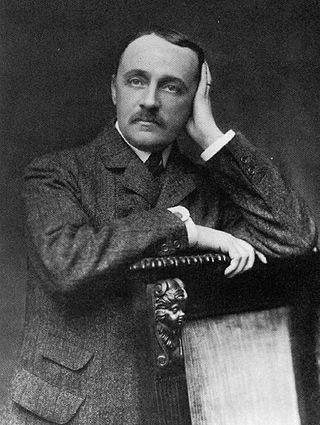
Ernest Archdeacon was a French lawyer and aviation pioneer before the First World War. He made his first balloon flight at the age of 20. He commissioned a copy of the 1902 Wright No. 3 glider but had only limited success. He was regarded as France's foremost promoter and sponsor of aviation, offering prizes, commissioning designs, and organising tests and events.

Victor Tatin (1843–1913) was a French engineer who created an early airplane, the Aéroplane, in 1879. The craft was the first model airplane to take off using its own power after a run on the ground.

The pioneer era of aviation was the period of aviation history between the first successful powered flight, generally accepted to have been made by the Wright Brothers on 17 December 1903, and the outbreak of the First World War in August 1914.
Several aviators have been claimed to be the first to fly a powered aeroplane. Much controversy surrounds these claims. It is generally accepted today that the Wright brothers were the first to achieve sustained and controlled powered manned flight, in 1903. It is popularly held in Brazil that their native citizen Alberto Santos-Dumont was the first successful aviator, discounting the Wright brothers' claim because their Flyer took off from a rail, and in later flights would sometimes employ a catapult. An editorial in the 2013 edition of Jane's All the World's Aircraft supported the claim of Gustave Whitehead. Claims by, or on behalf of, other pioneers such as Clement Ader have also been put forward from time to time.
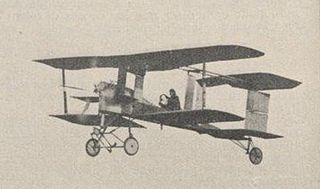
The Breguet Type II was the second fixed-wing aircraft design produced by Louis Breguet. Built during late 1909, it was soon discarded in favour of his next design, the Breguet Type III
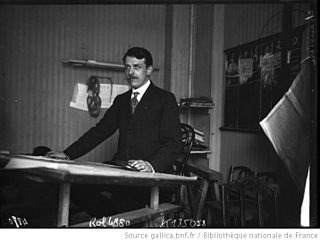
Lucien Chauvière (1876–1966) was a French aeronautical engineer. He is best known for his Integrale propellers, which were the first aerodynamically advanced propellers manufactured in Europe.






















